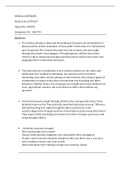PAMELA GOVENDER
Student No: 62754327
Unique No: 649298
Assignment 02- SAE3701
Question 1
1. Pre-colonial education embraced the building of character, the development of
physical ability and the attainment of honourable virtues that are a fundamental
part of maturity. Pre-colonial education was oral in nature and was taught
through the peoples own languages. Through legends, children learned the
virtues of their community and appreciated the power and beauty of their own
languages before colonization took place.
2. The main aspects of socialization in pre-colonial societies are the values and
beliefs that were instilled in individuals, the rules that were used when
interacting with others and the gaining of cultural norms. The primary agents of
socialisation are family as they have an important role in shaping the child’s
behaviour. Children from a very young age were taught how to feel, think and act
in an “appropriate” manner, and to do what was told to them without any
questions.
3. Formal learning was taught through initiation rites and apprenticeship. It was
distinctly known as the “hierarchically controlled educational system”. Whereas
informal learning was taught through the elders and parents in the
society/village/tribe through a practice of socialization (interacting with others).
They acquire skills, knowledge and values from their everyday experiences and
learnt through folklore.
4. –Authority structures changed
- New social groups were created
- African chiefs and their kingdoms were defeated by white subjugation
- People’s views towards education changed as they saw that it was a way into a
more leading economic and social system.
- Black individuals were willing to comply into monetary labour
, Question 2
1. Missionary schools were responsible for teaching children how to read and
write. They also taught obedience, manual work as well as convenient
education and a major emphasis was put on Christian principles. They were 2
sets of groups that were able to graduate from the school, children who got a
basic education that consisted of only reading and writing, and those who
received a higher level of education (math, etc).
2. The three aspects of mission education that was always criticised was the;
industrial and manual education (instead of teaching learners the proper
skills needed, they were taught about having the correct attitudes when
working), Racism and subordination(schools curriculum was based on
European history rather than local history. The black learners were only able
to get basic education, therefore only having limited job opportunities) and
lastly Sexism and woman’s subordination(They believed that females had to
be taught domestic values as they have no place in the economy)
3. The purpose of introducing Bantu education was to provide education to
black people. Its major condition was implementing racially separated
educational amenities. Bantu education was aimed to direct black or non-
white youth to the unskilled labour market.. Teaching took place in the
learner’s mother tongue, though the syllabus included classes in English
and Afrikaans. Lessons included needlework (for girls), handcraft, planting,
and soil management as well as Christian religion. The education aimed at
training the children for manual labour and tedious jobs that the government
saw appropriate for those of their race, and it was openly planned to
encourage the idea that black people were to accept being submissive to
white South Africans.
4. The criticism under the Bantu education act was mainly about how education
for black and non-white South Africans was built on a shallow foundation as
it underfunded. The training of teachers were poor and classrooms were
overcrowded. There was inadequate finance for people of colours education.
Question 3




